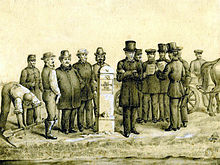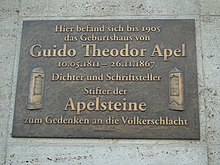Theodor Apel
Guido Theodor Apel (born May 11, 1811 in Leipzig ; † November 20, 1867 there ) was a German writer and founder of the Apelsteine to commemorate the Battle of Leipzig .
Life
Theodor Apel was born as the son of the Leipzig councilor and poet August Apel . As a pupil at the Nikolaischule and after school he was friends with Richard Wagner . From 1830 to 1834 Apel studied law at the universities of Leipzig and Heidelberg . In 1832 he became a member of the Corps Saxo-Borussia Heidelberg . So he was in Heidelberg in the same connection as Robert Schumann . He completed his studies with a doctorate. jur. from.
In Leipzig, Apel was previously Renonce with Corps Saxonia Leipzig . In 1835, Apel signed a petition for the re-admission of student associations at the University of Leipzig, albeit in vain. This was also done by other members of the Corps Saxonia who, like him, were in the circle of Richard Wagner, such as Bernhard Nake, Karl Louis Graf von Beust and Karl Allwill Graf von Tecklenburg.
Apel wrote dramas as well as lyrical and narrative poems. His piece of sewing tape from 1858 was a stage success.
Theodor Apel owned the Ermlitz manor near Schkeuditz , which he had acquired from his grandfather Heinrich Friedrich Innocentius Apel , where he also lived. He was married to Marie, née Ploß. After falling from his horse, he was almost completely blind from 1836 onwards.
Since the beginning of the 1860s, Apel has been committed to the memory of the Battle of the Nations near Leipzig and had 44 monuments erected at the sites of the troops in the battle, the so-called Apelsteine , at their own expense . He also wrote a guide to these stones with descriptions of the military leaders and the course of the battle. Newer guides to the monuments of the Battle of the Nations near Leipzig are those of Steffen Poser and Reinhard Münch.
In Leipzig, Apel also sat at the so-called crime table , where the democratic and progressive-minded part of the city's intellectual elite met. Apel is also on the tabletop with “Dr. Th Apel “recorded by name.
Since 1898 a street in the former Petzscher Mark in Leipzig has borne the name of the Apel family, who have been important in Leipzig for over 150 years, the Apelstraße .
Works
- Columbius (play, before 1835, Richard Wagner composes an overture to it: WWV 37a)
- Melusine (poem, 1844)
- The family doctor (1848)
- Professor Medlar (poem, 1854)
- Günther von Schwarzburg (Drama, 1856)
- Sewing kit (drama, 1858)
- The President's Daughter (Drama, 1858)
- Poet's love and home (drama, 1859)
- Guide to the battlefields of Leipzig in October 1813 and their landmarks (non-fiction book, 1863)
literature
- Rochus von Liliencron : Apel, Guido Theodor . In: Allgemeine Deutsche Biographie (ADB). Volume 1, Duncker & Humblot, Leipzig 1875, p. 500 f.
Web links
Individual evidence
- ↑ Thomas Pester, Between Music and Law - The "Boy Year" in Heidelberg 1829/30 , in: The academic "Schumann and the Jena PhD from 1840, edited by Joachim Bauer and Jens Blecher (publications of the Leipzig University Archives Vol. 14, ed. by Jens Blecher and Gerald Wiemers), Leipzig 2010, pp. 39–48, here p. 43.
- ↑ Kösener corps lists 1910, 120 , 151
- ↑ Richard Wagner to Theodor Apel, Leipzig 1910 (reprint London 2013), p. 3 f.
- ↑ Carl Friedrich Glasenapp , The Life of Richard Wagner, Vol. 1, 4th edition, Leipzig 1905, pp. 135-140. -Universitätsarchiv Leipzig (UAL): Holdings Rector: Rep. II Chap. IV No. 10 "Acta the petition submitted by the students Johann Eduard Naechster and Cons to amend the academic laws, in particular concerning the permission of student associations." (1830-1844).
- ↑ Horst Riedel: Stadtlexikon Leipzig, Pro Leipzig, 2005, p. 21f.
- ^ Theodor Apel: Guide to the battlefields of Leipzig in October 1813 and their landmarks. Hoffmann, Leipzig 1863. ( work as PDF file )
- ↑ Steffen Poser: Job 38:11. You should come this far and no further, your proud waves should lie here. Monuments tell about the Leipzig Battle of the Nations. Leipziger Hefte, Vol. 13 (published by the Leipziger Geschichtsverein e.V.), Sax-Verlag, Beucha 1998, ISBN 3-930076-66-7 .
- ↑ Reinhard Münch: Landmarks and monuments of the Battle of Nations in and around Leipzig. Barthel, Panitzsch 2000, ISBN 3-910188-28-1
- ↑ cf. Prim Berland: Hermann Marggraff. A German literary life. After his works and the letters he left behind, as well as contemporary journalism. Paris: Flory, 1942, p. 262.
- ↑ Gina Klank, Gernot Griebsch: Lexikon Leipziger Straßeennamen , Verlag im Wissenschaftszentrum Leipzig, 1995, ISBN 3-930433-09-5 , p. 27
| personal data | |
|---|---|
| SURNAME | Apel, Theodor |
| ALTERNATIVE NAMES | Apel, Guido Theodor (full name) |
| BRIEF DESCRIPTION | German writer and founder |
| DATE OF BIRTH | May 11, 1811 |
| PLACE OF BIRTH | Leipzig |
| DATE OF DEATH | November 20, 1867 |
| Place of death | Leipzig |


